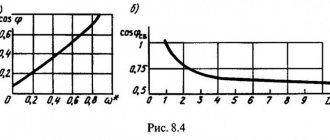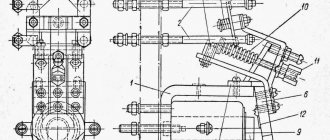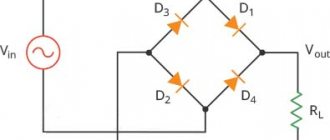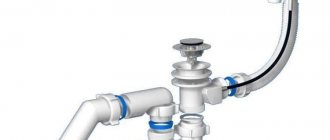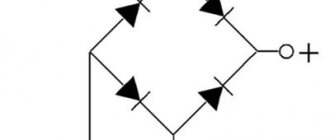When using a dimmer, rarely does anyone think about its structure and operating principle. However, a small electronic or mechanical device of a fairly simple design can significantly increase the level of comfort.
If you understand what a dimmer is and how it works, you can independently connect or even assemble a device useful in everyday life.
In this material we will tell you what a dimmer is and what it is needed for, and also provide instructions for installing this device yourself.
Purpose
The word “dimmer” comes from the English “dim”, which literally means “to darken” in Russian.
But Russians themselves often call a dimmer a dimmer, because it is an electronic device with which you can change electrical power (that is, adjust it up or down). Most often, such a device is used to control the lighting load. The dimmer is designed to change the brightness of the light emitted by LED lamps, as well as incandescent and halogen lamps.
The simplest example of a dimmer is a variable resistor (or rheostat). Back in the 19th century, German physicist Johann Poggendorff invented this device so that it could be used to regulate the voltage and current in an electrical circuit by increasing or decreasing resistance. A rheostat is a resistance-adjustable device and a conductive element. Resistance can change stepwise and smoothly. To obtain low brightness of light, it is necessary to reduce the voltage. But the resistance and current will be high, which will lead to strong heating of the device. So such a regulator is completely unprofitable; it will operate with low efficiency.
Autotransformers can also be used as a dimmer. Their use is due to their high efficiency; throughout the entire adjustable range, an almost undistorted voltage will be produced with the required frequency of 50 Hz. But autotransformers are quite large, weigh a lot, and require considerable mechanical effort to control them. In addition, such a device will be expensive.
Electronic dimmer - this option is the most profitable from an economic point of view. It is compact and has a slightly different operating principle. Let's talk about it in more detail.
What is a dimmer?
The word dimmer is translated from English as “dimmer,” which is completely true.
A compact electronic or electronic-mechanical device is used to turn on/off and adjust the power of lighting devices. In this regard, it received another common name - dimmer.
Indoor lighting is not the only area where dimmers are used, but it is thanks to this that they have become in demand in everyday life.
It is very convenient to habitually control the lighting load using a device that, in its structure and appearance, resembles a switch.
The prototype of the modern device was the rheostat, invented in the century before last by the German I. Poggendorff. The principle of operation was to regulate the voltage in the circuit by the resistance level.
The main disadvantage of the experimental setups is that to reduce the brightness of the lighting it was necessary to reduce the voltage. This increased the current and resistance, as a result of which the device became very hot and had reduced efficiency.
The efficiency was increased through the use of autotransformers with stable voltage and frequency parameters. But these are bulky installations that are inconvenient for domestic use. As a result, electronic models are recognized as the best - efficient, economical, and small in size.
Many device users believe that a dimmer can dramatically reduce electricity consumption and, accordingly, reduce expenses for its payment.
In fact, the savings are about 15-18%, but comfort still comes to the fore.
Here are just some examples of productive uses of a dimmer:
- reduced lighting, slight darkening in the evening to create a calm atmosphere in the bedroom, nursery or living room;
- embodiment of the design lighting picture;
- creating lighting for suspended ceiling structures;
- operation of the lighting system in various modes.
By reducing or increasing the power of ceiling or wall lights, you can completely change the surrounding interior.
With the advent of electronic models, the capabilities of dimmers have increased: you can set the mode of blinking, pulsation, smooth or sharp fading. There are programs that recreate unusual light patterns only by changing the power of lighting devices.
Application
What a dimmer is is more or less clear. Voltage is supplied to the lamp, we change its level and thus adjust the brightness of the lamp. Now a few words about when and where this device is used.
Agree, quite often situations arise when it is necessary to reduce the brightness of the light:
- often the flow of lighting needs to be reduced in the bedroom before going to bed;
- Some design rooms require changes in the light pattern;
- Sometimes indoor lighting is switched to the so-called standby mode in order to reduce energy consumption.
In industrial and domestic premises, LED lamps are configured for different consumption modes. At the same time, optimal lighting is selected and due to this, significant energy savings are achieved.
As for design ideas, it has now become fashionable in large living rooms or halls to use secondary lighting of individual areas. Secondary lighting is thought out to the smallest detail, and with the help of dimmers you can increase the lighting and focus attention on some interior details (a painting on the wall, a beautiful vase installed in a niche, etc.) Thus, with the help of lighting, the necessary thing comes out in the room first plan.
LED lamps, adjustable using dimmers, allow you to get a colorful effect during some concerts, advertising or special events.
The dimmer is very convenient for home parties. When guests are sitting at the table, bright lighting is required, but during dancing you can dim it. It is especially comfortable and beneficial to use such a device during a romantic dinner or date, when it is not necessary for the lamp to be on at full power. And these are just some of the general examples. Surely, everyone has their own option for using dimmers. So this thing is necessary, convenient and cost-effective; you can install it at home and recommend it to your friends.
Design and principle of operation of a dimmer
Now, as they say, let's look at the dimmer from the inside. What kind of device is this, and what elements does it consist of? What is its operating principle based on?
All modern electronic dimmers have a key in their design as a main element (it can also be called a switch or switch), which is controlled by semiconductor transistor, triac or thyristor devices. Most devices do not produce a sinusoidal signal at the output; the electronic key, as it were, cuts off sections of the sinusoid.
To make it clearer, a current flows in the electrical network, which has a sinusoidal shape. To change the brightness, you need to apply a trimmed sine wave to the lamp. A bidirectional thyristor cuts off the leading or trailing edge of a sinusoidal AC wave, thereby reducing the voltage supplying the lamp.
Depending on which front of the sine wave is cut off, the adjustable method differs:
- leading edge adjustment;
- falling edge adjustment.
Both of these methods are used to control different lamps:
- Dimming of LED and halogen lamps is carried out using electronic transformers, and adjustment is applied along the trailing edge.
- Compact fluorescent and LED lamps with a voltage of 220 V, as well as low voltage lamps, are regulated using electromagnetic transformers and using the leading edge method.
Both of these methods are suitable for incandescent lamps. The design of the dimmers also includes protection against short circuits and overheating. Since dimmers are capable of generating electromagnetic interference, to reduce their level, a choke or inductive-capacitive filters are connected in series to the circuit.
Operating principle
The main element of the dimmer is a key, also known as a switch, the operation of which is regulated by a thyristor or triac device. To reduce the brightness, a current supply from a trimmed sinusoidal shape is required; for this, a thyristor is used that cuts off the leading or trailing edge. The choice of control method depends on the type of lamp:
- For compact fluorescent light bulbs and reduced voltage devices, leading edge controlled electromagnetic transformers are used;
- For halogen and LED lamps, electronic regulators with voltage changes along the trailing edge are used.
In addition, the dimmer circuit includes components that protect the device from overheating and damage due to a short circuit. To reduce electromagnetic distortion, the system is supplemented with capacitive inductive filters or a special inductor is connected.
Pros and cons of use
Before purchasing a dimmer, you need to correctly assess the situation and decide whether there is really a need for it. Sometimes installing a dimmer in the house really turns out to be useful, since the device has remarkable advantages.
- The main function - increasing / decreasing the brightness of the light - is already interesting in itself. You can set a “working” mode, in which every speck of dust on the table is visible, or dim the light to a minimum to give peace to your eyes and relax
- The electronic filling of the device allows you to increase its capabilities, making control methods even more comfortable. For example, turning on/off by clap or a specific command, by sending a signal via radio or Wi-Fi
- Unlike step switching, smooth switching protects the circuit from sudden current surges, which contributes to the long service life of the lamps and the device itself. It is more difficult to make smooth adjustments using a knob, but the touch device works perfectly in this sense
- If there is a risk of robbery or for some reason it is necessary to create the impression of an apartment in which someone is constantly present, install a device with a presence simulation function. Lights turn on and off in different rooms
- Adjusting the brightness of the light in the room
- Expanded range of capabilities of modern models
- Smooth change in power and brightnessHuman presence simulation function
However, there are also disadvantages. The main ones are related to installation work. It may be necessary to change the wiring for installation, and then make cosmetic repairs. Some devices can disrupt the operation of sensitive devices because they cause electromagnetic interference.
Most dimmers are not universal, that is, they operate only with one type of lamp, for example, with traditional 40 W or 60 W incandescent lamps. If you want the efficiency of the device to reach its maximum, then the use of incandescent lamps should be avoided. Greater returns are expected from lighting fixtures based on LED sources.
What is a dimmer and how does it work: the design and operating principle of a typical dimmer
When using a dimmer, rarely does anyone think about its structure and operating principle. However, a small electronic or mechanical device of a fairly simple design can significantly increase the level of comfort.
If you understand what a dimmer is and how it works, you can independently connect or even assemble a device useful in everyday life.
In this material we will tell you what a dimmer is and what it is needed for, and also provide instructions for installing this device yourself.
What are the differences between dimmers?
If you are going to use a switch with brightness control, you first need to find out what they are. And in general, can all LED lamps be dimmed?
Dimmers differ according to the following criteria:
- By type of installation;
- on execution and method of management;
- according to the method of regulation.
Let's take a closer look at each of them.
By installation type
For outdoor installation – surface-mounted switch with dimmer for LED lamps. To install such a device, you do not need to drill a niche in the wall; it is simply mounted on top of the wall. It is very convenient to use in cases where the interior is not a priority or external wiring is installed.
For indoor installation - they will fit perfectly into any interior, such as this one.
For DIN rail mounting they are very specific and at first it may seem that they are not practical. However, this dimmer for LED lamps works with a remote control, and is hidden from prying eyes in the electrical panel.
By execution
According to the design, the light controller for LED and incandescent lamps can be:
- Rotary;
- rotary-push type;
- push-button;
- sensory;
Rotary is one of the simplest options for dimming an LED lamp; it looks unpretentious and has the simplest functionality.
The turn-and-push one looks almost the same as the rotary one. Thanks to its design, when you press it, the light turns on with the same brightness as it was set the last time you turned it on.
A push-button controller for LED lighting looks more technologically advanced and will fit seamlessly into a modern apartment. Like this switch with a dimmer for LED lamps.
Touch models can be completely different - from luminous circles to smooth single-color panels for adjusting the voltage of LED lamps.
According to the adjustment method
Dimmers vary not only in their design, but also in their operating principle. This applies specifically to AC dimmers.
The first type of dimmer is more common and cheaper, due to the simplicity of its circuit - a leading edge cutoff dimmer. A little further on, its operating principle and circuit will be discussed in detail; for comparison, take a look at the type of voltage at the output of such a regulator.
The graph shows that the remainder of the half-wave is supplied to the load, and its beginning is cut off. Due to the nature of the load switching on, interference is generated in the electrical networks, which interferes with the operation of televisions and other devices. A voltage of the set amplitude is applied to the lamp, and then it fades out when the sine wave passes through zero.
Can a leading edge dimmer be used for LED lamps? Can. LED lamps with a dimmer of this type will only be well adjustable if they were originally designed for this. This is evidenced by the symbols on its packaging. They are also called “dimmable”.
The second type works differently, creates less interference and works better with different light bulbs - this is a falling edge dimmer.
LED lamps with this type of dimmer adjust better, and its design better supports non-dimmable light sources. The only drawback is that these lamps can adjust their brightness not from “zero”, but within a certain range. At the same time, dimmable LED lamps are simply superbly adjustable.
The best solution is to use a Falling Edge LED dimmer.
A special word can be said about ready-made LED lamps with adjustable brightness. This is a separate class of lighting devices that do not require the installation of additional regulators, but have them in their design. Their adjustments are made using buttons on the case or from the remote control.
By control method
In domestic conditions, the most widely used are classic and affordable monoblock luminous flux controllers, which traditionally differ in the way they are controlled.
Types and types of dimmers (dimmers)
Dimmers can be divided according to the following factors:
- By place of application: residential premises or public, common premises;
- According to the installation method: installation in a mounting box (hidden), open, in a panel on a DIN rail (modular device);
- By control element: rotary, rotary push, keyboard (smart);
- By minimum and maximum power: up to 300 and up to 600 W, from 40 or from 60 W. There are industrial dimmers up to 1000W;
- According to the degree of protection from humidity: from IP 20;
- By type of load. Here I note that dimmers can work not only to regulate lighting, but also be used in circuits with halogen lamps, electronic, toroidal, winding (traditional) transformers;
- According to programming and timing capabilities.
Types of light bulbs
Dimmers use a variety of types of light sources: incandescent, halogen (regular and low-voltage), fluorescent, and LED bulbs. Options for connecting a dimmer with a switch differ depending on the type of lamps used.
Incandescent and halogen lamps
These light sources are rated for 220 volts. To change the lighting intensity, dimmers of any model are used, since the load is all active due to the lack of capacitance and inductance. The disadvantage of systems of this type is the shift of the color spectrum towards red. This happens when the voltage decreases. The power of the dimmers is between 60 and 600 watts.
Low voltage halogen light bulbs
To work with low-voltage lamps, you will need a step-down transformer with a regulator for inductive loads. A distinctive feature of the regulator is the marking with the abbreviation RL. It is recommended to purchase the transformer not separately from the dimmer, but as a built-in device. For an electronic transformer, capacitance indicators are established. For halogen light sources, the smoothness of voltage fluctuations plays an important role, otherwise the life of the bulbs will be sharply reduced.
Fluorescent lamps
The standard dimmer will have to be replaced with electronic ballasts (electronic ballasts) if the start is carried out by a switch, a starting glow charge or an electromagnetic choke. The simplest diagram of a system with fluorescent lamps is shown in the figure below.
The voltage to the light bulb is sent from a frequency generator of 20–50 kHz. The glow is formed due to the resonance of the circuit created by the inductor and capacitor. To change the current (which changes the brightness of the light) you need to change the frequency. The dimming process begins immediately after reaching full power.
Electronic ballasts are manufactured on the basis of the IRS2530D controller, equipped with eight outputs. This device acts as a half-bridge 600-volt driver with triggering, dimming, and anti-failure functionality. The integrated circuit is designed to implement all possible control methods due to the presence of multiple outputs. The figure below shows a control circuit for fluorescent light sources.
LED light bulbs
Although LEDs are economical, there is often a need to reduce their brightness.
Features of LED light sources:
- standard bases E, G, MR;
- ability to operate with a network without additional devices (for 12-volt lamps).
LED light bulbs are not compatible with standard dimmers. They simply fail. Therefore, to work with LEDs, special switches with brightness controls for LED lamps are used.
Regulators suitable for LEDs are available in two versions: with voltage control and with control via pulse-width modulation. The first type of device is very expensive and large (it includes a rheostat or potentiometer). Voltage dimmers are not the best choice for low-voltage light bulbs and can only operate on 9 and 18 volts.
This type of light source is characterized by a change in spectrum in response to voltage adjustment. For this reason, the adjustment of light diodes is carried out by monitoring the duration of the transmitted pulses. This way it is possible to avoid flickering, since the pulse repetition rate reaches 300 kHz.
In order for the lamp to work correctly, it contains a driver. The possibility of dimming is indicated in the product data sheet. If dimming is not possible, it is recommended to buy special devices with pulse-width control.
There are such PWM regulators:
- Modular. Control is carried out by remote controllers, remote controls or using special buses.
- Installed in an installation box. They are used as switches with rotary or push-button control.
- Remote systems installed in ceiling structures (for LED strips and spotlights).
Pulse width control requires expensive microcontrollers. Moreover, they cannot be repaired. It is possible to independently manufacture a device based on a microcircuit. Below is a dimmer circuit for LED light bulbs.
Normal frequency of oscillations is achieved through the use of a generator, which contains a capacitor and a resistor. The intervals for connecting and disconnecting the load at the output of the microcircuit are set by the size of the variable resistor. A field-effect transistor serves as a power amplifier. If the current is higher than 1 ampere, a cooling radiator will be needed.
Dimmers used in everyday life
In residential buildings and apartments, dimmers are used, installed in a mounting box (under spacer tabs or under screws), with a power of up to 300 W, often with a rotary control mechanism.
In the photo you see an example of a company dimmer. Light regulation is carried out by turning the lever, the right light increases. To the left the light decreases. It's simple.
Related articles: How to connect LED backlight power supplies - connection diagrams
Connection diagrams
Installation is carried out in a certain sequence. After turning off the power, make sure that the switch is de-energized. Then the cover of the device is removed from the body, the fastenings are loosened and the device is removed from the niche in the wall. If the insulating layer of the wires is damaged, the open areas must be covered with several layers of electrical tape. The wires are connected to the dimmer terminals, making sure that their bare ends are up to 3 mm long. The dimmer with connected wires is placed in place of the switch and securely fixed. All that remains is to connect the power and check that the device is working properly.
Recommendations for selection
To choose the right device, you should study the installation options:
- The standard connection option is to control the light from one point in the room.
- In bedrooms, you can install two devices - at the entrance to the room and near the bed, which allows you to change the intensity of lighting when going to bed.
- Let’s assume an option where light control is carried out from one place, and control is carried out from two. This could be a switch at the entrance and two regulators in different areas of the room.
- Option in the ratio “three control points and one control point.” Here you can use pass-through dimmers, when turning on lamps in one area of the room automatically turns off lighting devices in others.
Two dimmers and one switch
Control from two points
Control from one point
A variety of ways to connect a dimmer allows you to choose the best option for each room, taking into account the characteristics of its operation.
Triac dimmer circuit
The circuit of triac brightness controllers is basically the same everywhere, differing only in the presence of additional parts for more stable operation at low “output” voltages and for smooth regulation. Also, details are introduced into the circuit to reduce the level of interference generated by the dimer into the network.
The operating principle of the circuit is as follows. In order for the lamp to light up, the triac must pass current through itself. This will happen when a certain voltage appears between the electrodes of triac A1 and G (which one - see in the datasheet, can be downloaded at the bottom of the article). This is how it appears.
At the beginning of the positive half-wave, the capacitor begins to charge through the potentiometer R. It is clear that the charging speed depends on the value of R. In smart words, the potentiometer changes the phase angle. When the voltage on the capacitor reaches a value sufficient to open the triac and dinistor (see datasheet for dinistor), the triac opens. In other words, its resistance becomes very small, and the light bulb burns until the end of the half-wave.
The same thing happens with the negative half-wave, since diac and triac are symmetrical devices, and they do not care in which direction the current flows through them. As a result, it turns out that the voltage on the active load represents “stubs” of negative and positive half-waves, which follow each other with a frequency of 100 Hz. At low brightness, when the lamp is powered by very short “pieces” of voltage, flickering is noticeable. The same cannot be said about rheostat regulators and regulators with frequency conversion.
This is what a real light controller circuit looks like. The parameters of the elements are indicated taking into account the variation among different manufacturers, but this does not change the essence. You can install any triacs in this circuit, depending on the load power. Voltage - not lower than 400 V, since the instantaneous voltage in the network can reach 350 V. Dinistor - DB3, in extreme cases DB4. The starting and ending points of ignition and the stability of the lamp’s combustion depend on the size of the capacitors and resistors.
At the maximum resistance of resistor R1, there will be minimal lamp burning, since the triac will open at the end of the half-wave, or will not open at all.
Alternative uses of a dimmer
The fact that a dimmer can only regulate the brightness of incandescent lamps is the narrow-mindedness of marketers; it has many more applications. A dimmer is not only a lighting regulator, it can be used as a voltage regulator in general, connecting any active load through it - an incandescent lamp, a soldering iron, a kettle, an iron. But the main thing is that the maximum power of the dimmer (in other words, the maximum current of the triac) must correspond to the load.
It is not a fact that the load will behave adequately and will not be in danger of failure. For example, try dimming your TV) No, better not! In addition, you can, for example, regulate the temperature of underfloor heating. This eliminates the need to purchase a temperature controller, which costs 3-5 times more.
The downside is that there is no feedback and protection against overheating, but in many cases this is tolerable. After all, there is no feedback from the chandelier either - only through the eyes. And from the warm floor - through the legs, right? I installed dimmers on heated floors, they work great for many years.

